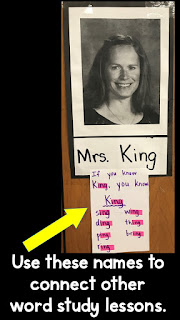"But one of the things that we never
discuss or we rarely discuss
is the value and importance of human connection...relationships."
Rita
Pierson
“No
significant learning occurs without a significant relationship.”
James
Comer
“A
relationship can begin by simply knowing someone’s name.”
Jessica
Pelka
In our classroom, we always make birthday cards at the writing center when it's someone's birthday, including staff members. Last year, it was April, and at the writing center that day, we were going to be making Mrs. Seelow a birthday card.
When I was giving instructions, a student asked, "Who's Mrs. Seelow?" I couldn't believe my ears!!?? "Who is Mrs. Seelow," I repeated. I was met with blank stares.
Mrs. Seelow is a para-professional in our building. She assists the kids in the lunchroom, is outside during recess, and is often times in our classroom and/or the hallway. She is everywhere! How could the kids not know who Mrs. Seelow was?
I brought her picture up on the smartboard and instantly everyone recognized her face. "Ohhhhhh, yeah. We know her."
Ummmm....I hope so. It's April.
Yes, I was extremely disheartened. Of course, I had introduced the kids to Mrs. Seelow (and all the staff members at our school) and they had seen her almost daily for eight months, but that was not enough. Relationships are VITAL for growing healthy, caring citizens. Yep. I sure hit this one out of the ballpark. Ughhhh....
I had to do more to help my kids get to know the adults in the building. So far, what I was doing wasn't working.
That's when I decided that I had to do something completely different.
I decided to create a class display of all the staff members in our building that my kids would come into contact with. Please note: This wall started completely blank. We, as a class, took every step together as each picture was added. This was not a teacher project or a student project, this was a team project.
I don't want to ruin the surprise, but want you to see what I'm explaining. Here's a look at our (almost) end product.
Here's how I did it: Before the kids arrived, I ran off 8.5x11 sized pictures of each staff member (from our school website) and taped it to a black piece of construction paper. Then I added a blank piece of paper under the picture for the person's name. This was the only piece of the project that happened without my students and it was definitely not fancy.
I started with my name. Maybe it would help from being called "Teacher" for the first two weeks of school? I also added our classroom support teacher.
I started by showing my kindergarten students my picture and saying, "This is my picture. This is me. My name is Mrs. Pelka. I'm going to write my name on this piece of paper. Readers know that PICTURES and WORDS need to match."
I continued doing this, one new picture a day, for the whole first week. Very soon, the kids were repeating the rule "pictures and words need to match" with me each time. We then read the names together, using a crisp pointer, making sure that our eyes, voice, and finger all matched. We reread several times that day. I often times would see the kids coming up to our easel, imitating me, reading the names.
Then together, we started saying the words slowly and putting down the sounds of the name that we could hear. I would ask kids to come up to our alphabet chart to find the corresponding sound.
It was only week one, day four of kindergarten and I was already modeling early reading and writing skills. I thought to myself..."Hey, there is more to this than just learning everyone's names."
We were building classroom and school community, I was modeling the writing process, and students were engaged in the reading process.
Needless to say, this was a hit! Several teachers, of all grade levels, commented on wanting to do a wall like this in their classroom. A 5th grade teacher remarked, "I know my kids don't know all of the staff in our building and they've been here for 6 years."
Academically, the growth my students made over the school year was incredible. I know it's because I began teaching the reading and writing process through my modeling beginning the first hour on the first day of school. We never stopped acting like readers and writers from that moment forward. We used this wall to study words and how words worked. Natural connections make unnatural learning very easy!


Please know that I didn't have the smartest kids, the kids from the best families, or the best behaved students. I had behaviors coming out of my ears, but did almost every single one of my students make reading and writing benchmarks this year?
Yes, but THIS ISN'T EVEN THE BEST PART. Everyday while walking down the hallway, or entering a room, I would hear my students greeting the adults in our building, BY NAME. They knew the people around them and felt connected to them and our school. There isn't any better feeling in the world than this.
Here's the supporting documents along with a video: Make Every Moment Count! Together, we are going to change the world! Thanks for reading!






























































